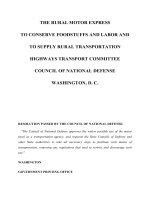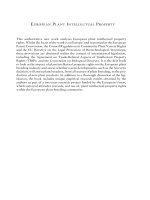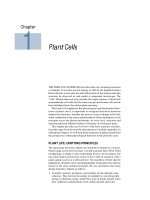Stem root plant anatomy lab
Bạn đang xem bản rút gọn của tài liệu. Xem và tải ngay bản đầy đủ của tài liệu tại đây (701.92 KB, 9 trang )
STEM
Purpose: To compare and contrast the internal organization of
monocot and dicot stems.
Materials: Cross section prepared slides of stems
Typically, stems are responsible for holding the leaves up to the light so
photosynthesis can occur, and they conduct minerals and water
absorbed by the roots to other regions of the plant. There are 4 types
of stem in anatomical structure:
Procedure:
Obtain a prepared slide of stems.
Identify the type of the stem under microscope with scanning
power.
If the stem looks like type I then you turn to page 19.
If the stem looks like type 2 or 3 then you turn to page 18.
If the stem look like type 4, turn to page 17.
15
16
PART I. MONOCOT STEM
Examine a prepared slide of Zea mays stem under the
microscope.
Use the image on page 15 and locate the following structures:
epidermis, cortex, vascular bundle, xylem, phloem.
Sketch and label a vascular bundle
Answer questions 1-5
1. What is the shape and function of the epidermal cells?
2. How are the vascular bundles arranged throughout the cross-section
of the stem?
3. Describe how can you differentiate between xylem and phloem
tissue? Give at least 2 answers!
4. What type of tissue surrounds the vascular bundle?
5. What is the function of the tissue in question 13?
17
PART II. DICOT STEM: HERBACEOUS
Examine a slide of a cross section of Helianthus stem. Identify:
the primary and secondary xylem, primary and secondary phloem,
pith, cortex and epidermis, vascular cambium.
Answer questions 6-12
6. Write down the tissues and cells of the Helianthus stem from outermost to
innermost?
7. Just outside the xylem is the cambium, how does it differ in appearance from
the xylem? Give at least 2 answers!
8. Just outside the cambium is the phloem, how does it differ from the
cambium? Give at least 2 answers!
9. What kind of tissue make up the pith?
10. You may see some group of sclerenchyma cells outside the phloem. What are
they?
Examine a slide of a cross section of a Rannunculus stem. Identify the pith,
vascular bundle, xylem, phloem, cortex and epidermis.
11. What is the difference in pith structure of this two plant?
12. Rannunculus is generally found on the margins of wetlands. Which structure
describe its ecological type? (2 points) What is the term of its ground tissue?
18
PART III. DICOT STEM: WOODY
Examine a slide of a cross section of a Hibiscus stem. Identify the
pith, xylem, vascular cambium, phloem, cortex and periderm
(cork, cork cambium, lenticel …).
Answer questions 13-17
13. Write down the tissues and cells of the Hibiscus stem from
outermost to innermost?
14. What is difference in dermal tissue between Hibicus and
Helianthus stems?
15. Based on the vascular tissues, how old is this plan?
16. Can you find phloem fiber in this plan?
17. Compare the monocot and dicot stems? (Give at least 2 answers)
19
ROOT
Purpose: To compare and contrast the internal organization of
monocot and dicot roots.
Materials: Cross section prepared slides of roots.
20
PART I. MONOCOT ROOT
Examine a prepared slide of Zea mays root under the microscope.
Use the image on page 15 and locate the following structures:
epidermis, cortex, endodermis with Casparian strips, pericycle,
protoxylem poles, xylem, phloem.
Answer questions 1-6
1. Write down the tissues and structures of the root from outermost to
innermost?
2. What type of tissues make up the cortex of the root?
3. What is the endodermis?
4. What is Casparian strips?
5. What does its function?
6. How many protoxylem poles in the root?
21
PART II. DICOT ROOT
Examine a prepared slide of Rannunculus or Cucurbita pepo root
under the microscope.
Use the image on page 15 and locate the following structures:
epidermis, cortex, endodermis, pericycle, protoxylem poles,
xylem, phloem.
Answer questions 7-10
7. How many protoxylem poles in the root?
8. Why can’t you find the Casparian strips?
9. How does the dicot root differ from the monocot root? (2 points)
10.
22
How do roots compare to stems? (Give at least 2 answers)
PART III. EXAM A ROOT
Examine a prepared slide of root under the microscope.
1. Can you identify the plant is monocot or dicot?Why
2. Can you guest the environment where plant live?Why?
3. Sketch and label structures of the root.
23









